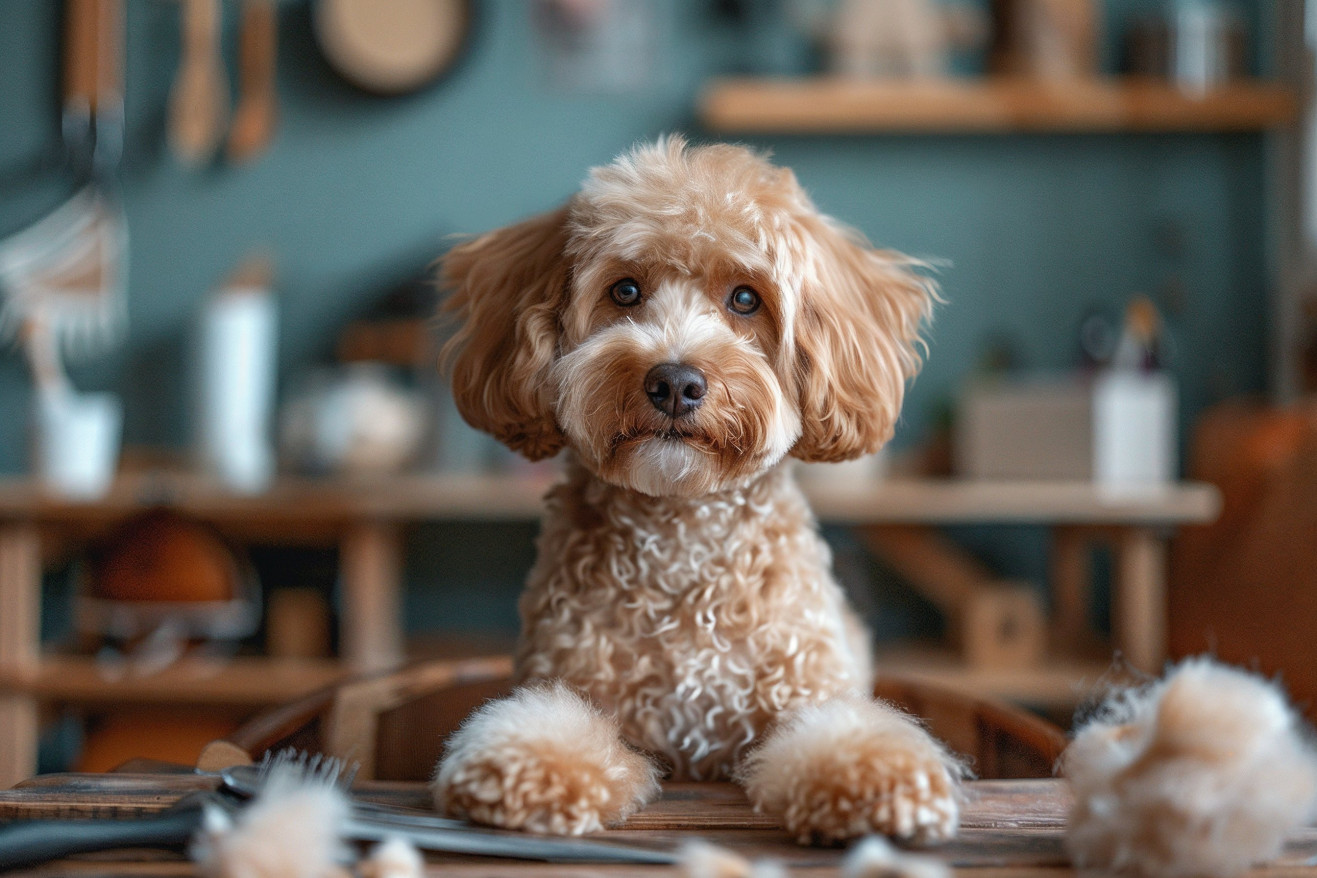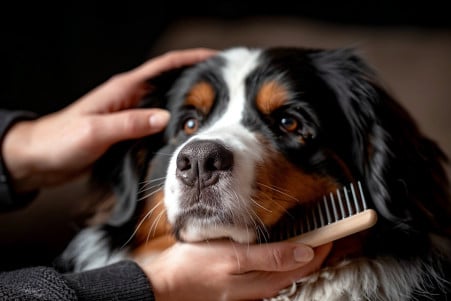Goldendoodle Shedding: Understanding Your Doodle’s Coat
4 March 2024 • Updated 4 March 2024

Goldendoodles are beloved for their adorable appearance, but their shedding can be a source of confusion for pet parents. Although Goldendoodles tend to shed less than their Golden Retriever ancestors due to their Poodle lineage, they are not completely hypoallergenic, and the amount they shed can depend on their coat type, with curlier coats shedding less. However, with regular grooming, Goldendoodles can be a good option for many people with allergies.
In the sections below, we will take an interdisciplinary approach to this topic, drawing on research from genetics, veterinary science, and animal care to better understand Goldendoodle shedding. This will involve a look at research on coat genetics, the impact of diet and stress on shedding, and the best grooming techniques.
Our hope is to give you a comprehensive understanding of what to expect from a Goldendoodle’s coat and how to ensure it’s properly maintained for the benefit of both the animal and the owner.
Do Goldendoodles shed?
Genetics of Goldendoodle Shedding
The genetics of a Goldendoodle’s coat are quite complex, and the blueprint for a Goldendoodle’s shedding is no exception. According to Paw Print Genetics, the SD Locus (Shedding) is the most important gene in the determination of a dog’s shedding level. By looking at a dog’s SD Locus, you can tell if they are a high, moderate, or low shedder.
The genetic marker in the MC5R gene impacts the sebum composition in the hair follicle, which then impacts shedding.
Genetics also play a big role in the curly coat that is inherited from the Poodle. The curls of the Poodle’s coat are what make them low shedding, as the curls of their hair trap dander and hair in their coat.
In addition to the SD Locus, genetic testing for the Improper Coat (IC) and furnishings genes can also provide more information. According to Timberidge Goldendoodles, a dog with two copies of the furnishings gene is the best for reducing allergenic dander exposure.
For both breeders and pet parents, these genetic tests are useful for predicting the shedding of a Goldendoodle. This knowledge can also help breeders and pet parents better understand how to take care of their dog’s coat, which brings us to the importance of a good diet in maintaining a healthy, shiny coat with minimal shedding.
Supporting the Goldendoodle Coat from the Inside
The key to a healthy Goldendoodle coat may be found in the dog food you buy. After all, good nutrition is about more than just keeping your dog’s energy up—it’s also about taking care of their skin and coat.
Essential fatty acids, especially omega-3 and omega-6, help promote a healthy, shiny coat. WebMD explains that these fatty acids are important for skin health, which helps make sure the coat is healthy and less likely to shed.
If your Goldendoodle is lacking in these fatty acids, it can lead to excessive shedding and poor coat quality. A well-rounded diet, as The Honest Kitchen points out, that includes high-quality proteins and fats and is free of common allergens and fillers can help reduce shedding. Essential vitamins and minerals, such as biotin and zinc, are also called out by IAMS as important for healthy skin.
Make sure you’re feeding your Goldendoodle dog food that’s packed with these essential nutrients to help keep their coat healthy. These dietary needs can help set the stage for a healthy, manageable coat that requires less grooming and supports your dog’s overall health. By making sure you’re consistently feeding your dog a diet that includes these essential nutrients, you can help make sure your furry friend’s coat stays as golden as their name.
Learning to Groom to Minimize Goldendoodle Shedding
In addition to keeping your Goldendoodle looking and feeling its best, regular grooming can help you stay ahead of shedding. The right grooming schedule can help you catch loose hair before it ends up all over your house.
According to the Goldendoodle Association of North America, the different coat types, from straight to curly, require different grooming methods. For example, a curly coat may need a slicker brush to detangle and gather loose hair, while a wavy coat may need a pin brush and a metal comb to get the job done.
It’s also important to make sure you’re using the right products. The Fi Team says that using a high-quality shampoo can help maintain coat health and minimize shedding. It’s also important to make sure you’re using products that are right for your dog’s skin and coat type. For example, Vetericyn’s Foamcare Pet Shampoo is formulated to help with skin problems that can lead to shedding.
Grooming is also a time when you can check your dog’s skin and coat for things like mats, tangles, or skin conditions that could impact shedding. By sticking to a regular grooming schedule, you can make sure that you’re staying on top of shedding and keeping an eye on your Goldendoodle’s coat health, which will help you catch and address any problems early.
Stress and Shedding: How Goldendoodle Health Impacts Coat Quality
While Goldendoodles are generally low-shedding dogs, there are a few things that can disrupt their shedding patterns. PetMD notes that everything from stress to skin parasites can cause an increase in shedding.
The hormone epinephrine is the main stress hormone that can lead to stress-related hair loss, according to Rover. If you’ve noticed your Goldendoodle’s hair falling out more during times of stress or change, it’s not just because they’re reacting to the sound of the vacuum.
Stress-related shedding can lead to hair loss, dry and brittle hair, and an increase in hair around the home, and it can look a lot like other health issues. Some health problems that can cause an increase in shedding include food allergies, hormonal imbalances, and infections, according to PetMD.
If your Goldendoodle’s shedding is different than usual or if it’s accompanied by other symptoms like scratching or changes in the skin, it’s important to talk to a vet.
As a result, managing shedding in Goldendoodles is about more than just grooming and diet. It also requires a focus on overall health and stress. That said, it’s important to know when shedding is a sign of a bigger health issue to ensure that your Goldendoodle has a healthy coat and a happy life.
In Conclusion: The Many Layers of the Goldendoodle’s Coat
So, we’ve peeled back the layers of the Goldendoodle’s shedding mystery to find that while they are less likely to shed than Golden Retrievers, they are not completely hypoallergenic.
As both Love Your Dog and A-Z Animals point out, a number of factors come into play to determine how much a Goldendoodle will shed. Genetics is a big part of it, as some dogs will inherit the low-shedding coat of the Poodle and others the higher-shedding coat of the Golden Retriever.
A healthy diet and regular grooming are also important to keeping a Goldendoodle’s coat in good shape. A healthy diet will help keep the coat healthy from the inside out, while regular grooming will help remove loose hair and reduce shedding. In addition, as Fi points out, it’s important to make sure that stress and other health issues are managed, as these can also have a big impact on how much a dog sheds.
So, in the end, the key to managing shedding is to understand and meet the needs of your individual Goldendoodle. While there is no one-size-fits-all answer, a combination of genetics, diet, grooming, and health care will help you make sure that you’re meeting the needs of your Goldendoodle’s coat in the best way possible.


